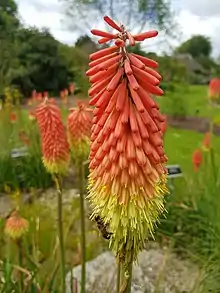| Kniphofia × praecox | |
|---|---|
 | |
| Scientific classification | |
| Kingdom: | Plantae |
| Clade: | Tracheophytes |
| Clade: | Angiosperms |
| Clade: | Monocots |
| Order: | Asparagales |
| Family: | Asphodelaceae |
| Subfamily: | Asphodeloideae |
| Genus: | Kniphofia |
| Species: | K. × praecox |
| Binomial name | |
| Kniphofia × praecox Baker | |
| Synonyms[1] | |
| |
Kniphofia × praecox, also known as Kniphofia praecox or the greater red-hot poker[2] is a species of flowering plant in the family Asphodelaceae.
This species is believed to be the result of hybridization between Kniphofia uvaria and Kniphofia bruceae, leading to it being referred to as Kniphofia × praecox.[1]
Description
Kniphofia × praecox is a clump forming perennial species, with narrow grass-like leaves. Leaves can reach a maximum length of 2 metres. Plants produce upright, long flower stalks.[3] Due to the plants flower stalks they can reach a height of 1.5 metres tall.[4] Stems host a cylindrical cluster of flowers.[3] Flower buds start off scarlet red and transition to a reddish-orange and then yellow as they mature.[4]
Distribution
Kniphofia × praecox is native to South Africa, where it is found from the Swartberg Mountains to the Eastern Cape.[3]
The species is used in gardens around the world as an ornamental plant.[2] Here it was able to escape into the wild and grow outside of its natural range. Wild populations have been recorded within the United Kingdom, Belgium, New Zealand, Colombia and Ecuador.[5]
Habitat
Kniphofia × praecox naturally grows alongside streams, riverbanks and marshland habitats.[4]
It is naturally found at elevations of around 2400 metres above sea level.[1]
Outside of its natural range it has been recorded to grow on the verges of railway tracks.[6]
References
- 1 2 3 "Kniphofia × praecox". Plants of the World Online. Royal Botanic Gardens, Kew. Retrieved 14 April 2022.
- 1 2 "Kniphofia × praecox". www.rhs.org.uk. 2022-04-14. Retrieved 2022-04-14.
- 1 2 3 "Kniphofia praecox". www.pacificbulbsociety.org. 2018-04-21. Retrieved 2022-04-14.
- 1 2 3 De Moor, Lubke, Irene J., Roy (1998). Field Guide to the Eastern & Southern Cape Coasts. Cape Town: University of Cape Town Press. p. 246. ISBN 9781919713038.
{{cite book}}: CS1 maint: multiple names: authors list (link) - ↑ "Kniphofia × praecox". Global Biodiversity Information Facility. Retrieved 14 April 2022.
- ↑ "Kniphofia × praecox". https://alienplantsbelgium. 2022-04-14. Retrieved 2022-04-14.